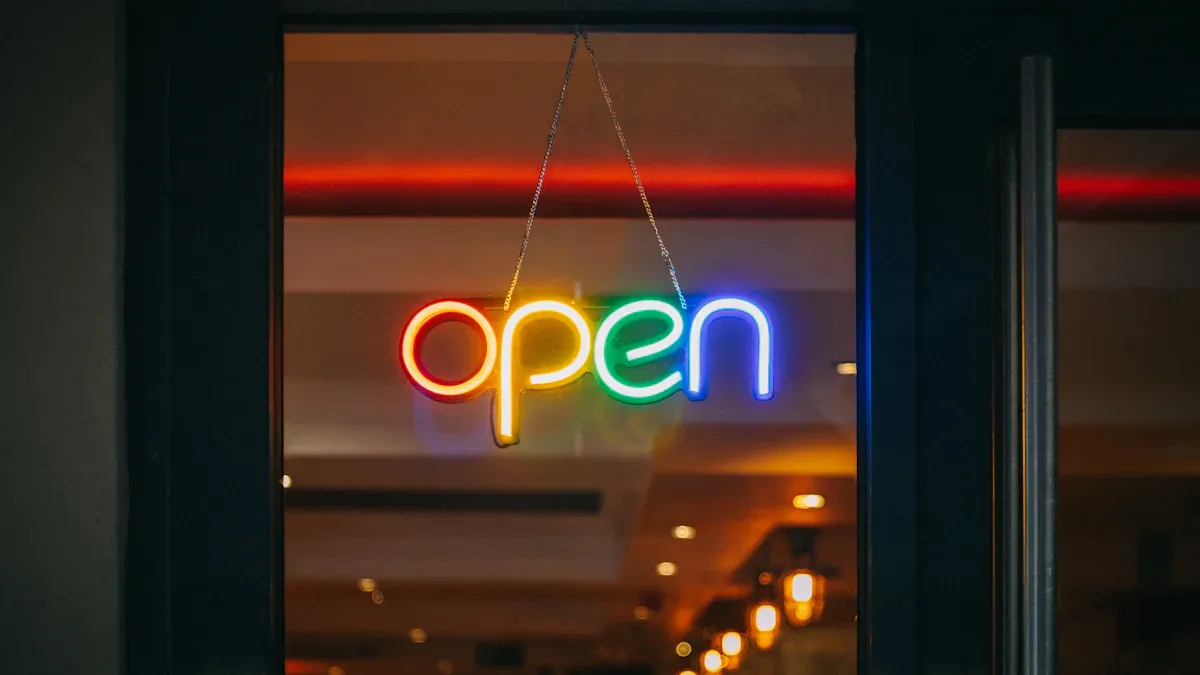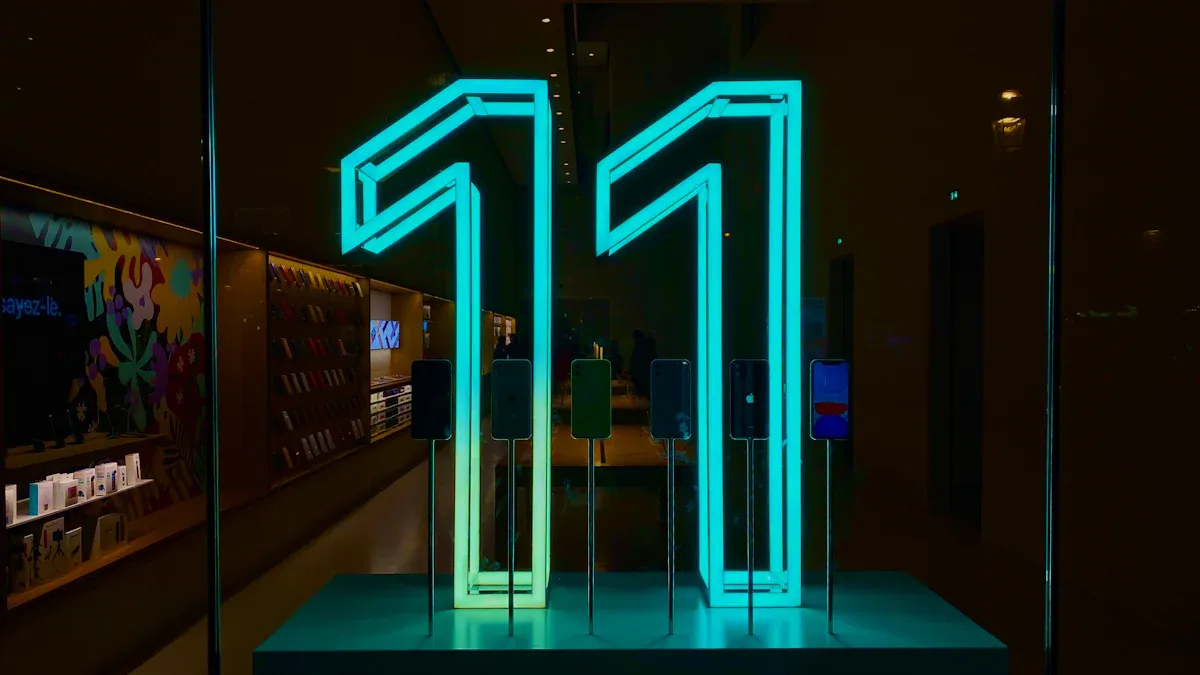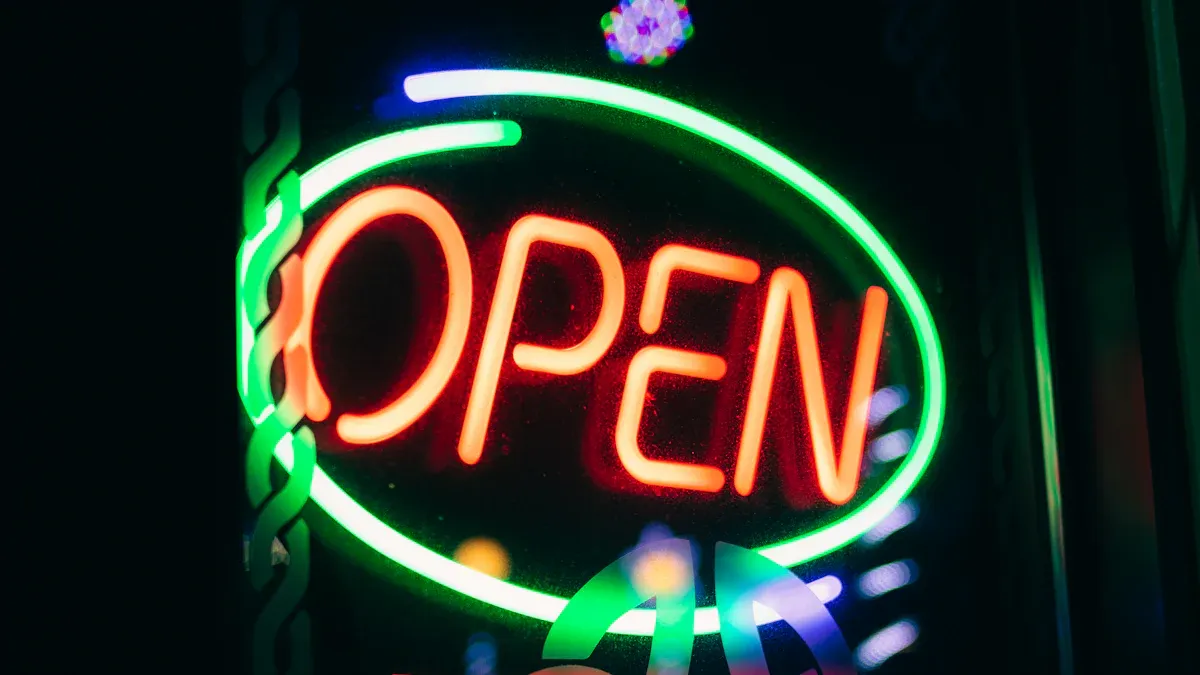Your cart is currently empty!
How to Produce a Luminous Signboard for Doorways in 2025

To produce a luminous signboard for your doorway in 2025, you start by selecting the right type of Signage for your needs. You choose durable materials, design the layout, fabricate the parts, assemble the components, and install the finished sign. High visibility, weather resistance, and following local codes matter. Both business owners and DIY enthusiasts can complete this process with modern tools and materials.
Key Takeaways
- Choose the right luminous signboard type based on your style, visibility needs, and location to make your doorway stand out.
- Use durable materials like acrylic and metal with waterproof features to ensure your sign lasts through all weather conditions.
- Plan carefully by measuring space, designing clearly, and checking local codes to avoid problems and create an effective sign.
- Follow precise fabrication, assembly, and installation steps to build a safe, bright, and long-lasting sign.
- Maintain your sign regularly by cleaning, inspecting wiring, and testing backup power to keep it looking sharp and working well.
Luminous Signboard Types

Choosing the right type of luminous signboard for your doorway in 2025 helps you achieve maximum visibility and style. Each type offers unique features and suits different needs.
LED Channel Letters
LED channel letters give you a modern, professional look. You can customize the font, size, and color to match your brand or personal taste. These signs use energy-efficient LEDs, which lower your electricity costs and require less maintenance. You often see LED channel letters on storefronts and office entrances.
Tip: Choose LED channel letters if you want bold, individual letters that stand out day and night.
Pros:
- High brightness
- Long lifespan
- Wide customization options
Cons:
- Higher upfront cost
- Requires precise installation
Light Box Signs
Light box signs use a translucent panel with internal lighting. You can print any design, logo, or message on the panel. These signs work well for both businesses and homes. You get even illumination and clear visibility from a distance.
Pros:
- Versatile design options
- Good for logos and graphics
- Easy to update graphics
Cons:
- Bulkier than other types
- May need regular cleaning
Neon and Faux-Neon
Neon and faux-neon signs create a classic, eye-catching glow. Faux-neon uses flexible LED tubing, which is safer and more energy-efficient than traditional neon. You can bend the tubing into almost any shape or script.
Pros:
- Unique visual appeal
- Custom shapes and colors
- Low voltage (faux-neon)
Cons:
- Traditional neon is fragile
- Faux-neon may not match real neon’s brightness
Illuminated Plaques
Illuminated plaques offer a sleek, subtle look. You can engrave or print your text and backlight it with LEDs. These signs suit upscale businesses, apartments, or homes.
Pros:
- Elegant appearance
- Durable materials
- Low energy use
Cons:
- Limited size options
- Less visible from a distance
When you select a luminous signboard type, consider your location, branding, and local code requirements. The right choice ensures your sign stands out and lasts for years.
Materials and Features
Acrylic and Metal
You want your luminous signboard to last for years, so you need to choose materials that can handle outdoor conditions. Acrylic and metal stand out as top choices. Acrylic letters transmit up to 93% of visible light, which gives your sign excellent clarity and brightness. This material is lightweight, weatherproof, and resists UV rays, rain, snow, and insects. You get a sign that stays vibrant and clear, even after years outside.
Metal options like aluminum and stainless steel offer impressive durability. Aluminum resists rust and remains lightweight, while stainless steel stands up to moisture and harsh weather. Manufacturers often use powder coating to add a protective layer, which prevents rust, scratches, and fading. Your sign keeps its structure and looks sharp, even in tough environments.
Waterproofing
Outdoor signs face rain, dust, and temperature swings. You need waterproofing to protect your investment. Many modern signboards use IP68-rated enclosures and weather-resistant materials. These features keep internal components safe from water and dust, so your luminous signboard works reliably in any season. Some signs also include thermal regulation systems and fortified connectors, which help maintain performance during storms or extreme heat.
Tip: Always check for waterproof ratings like IP68 when selecting materials and enclosures for your sign.
Lighting Options
Lighting technology has advanced quickly. You can now choose from energy-efficient LED backlighting, sunlight-readable displays, and even ambient light sensors. LEDs use less power and last longer than older bulbs. Some systems adjust brightness automatically, so your sign stays visible in direct sunlight or at night. Brands like Samsung offer models with smart brightness control and AI-powered content optimization, which help your sign look its best at all times.
- LED: Energy-saving, long lifespan, bright colors
- EL (Electroluminescent): Thin, flexible, even light
- Neon/Faux-Neon: Classic glow, custom shapes
Customization
You can customize almost every aspect of your sign. Pick the size, font, color, and lighting effects that match your brand or personal style. Many systems let you update graphics or messages remotely using cloud-based content management. This flexibility helps you keep your sign fresh and relevant, whether you run a business or want to add personality to your home entrance.
Customization ensures your luminous signboard stands out and meets your unique needs.
Production Steps

Planning and Design
You begin every successful luminous signboard project with careful planning and design. Start by defining your goals. Do you want to attract more customers, improve brand visibility, or simply mark your doorway with style? Measure your available space and consider the viewing distance. Sketch your ideas or use digital design tools to visualize the final look.
Collaboration plays a key role in this stage. Work closely with designers, fabricators, and stakeholders to ensure your vision aligns with practical requirements. The IDS Signage Company demonstrates how a structured process—combining concept development, value engineering, and project management—leads to efficient, high-quality results. Their approach shows that teamwork and evidence-based research help you avoid costly mistakes and deliver a sign that meets your needs.
Many businesses have seen real benefits from thoughtful planning. For example, a local café boosted customer visits by replacing a dull sign with a vibrant, custom design that reflected its personality. A tech startup improved engagement by installing a dynamic digital signboard that could update in real time. These cases highlight the impact of design choices on business performance.
Tip: Always check local zoning laws and building codes before finalizing your design. Early compliance saves time and prevents legal issues later.
Fabrication
Once you finalize your design, move to fabrication. Select high-quality materials like acrylic or metal for durability. Use precise cutting tools—such as CNC routers or laser cutters—to shape the components. If your design includes graphics or logos, apply them using UV printing or vinyl overlays.
Install the lighting system next. For most modern signboards, LED modules offer the best mix of brightness, energy efficiency, and longevity. Secure the LEDs inside channels, behind panels, or along the edges, depending on your chosen sign type. Test each lighting element to ensure even illumination and proper color.
Note: Investing in quality materials and skilled craftsmanship pays off in the long run. Durable signs require less maintenance and maintain their appearance for years.
Assembly
With all parts ready, assemble your luminous signboard. Begin by attaching the main structure—such as the frame or backing panel. Mount the illuminated elements, making sure all wiring stays organized and protected from moisture. Use waterproof connectors and seal any openings to prevent water damage.
Connect the power supply and control systems. Many modern signs include smart controllers that let you adjust brightness or change messages remotely. Test the entire assembly for stability, lighting performance, and safety.
- Double-check all fasteners and seals.
- Confirm that lighting works as intended.
- Ensure wiring meets electrical codes.
Tip: Keep assembly instructions and wiring diagrams for future maintenance or repairs.
Installation
Proper installation ensures your sign performs well and stays safe. Choose a mounting location that maximizes visibility without violating local codes. Most regulations restrict sign placement near intersections or visibility triangles to protect drivers and pedestrians. Mount your sign at the recommended height and angle for easy reading.
Secure the sign using appropriate anchors, brackets, or wall mounts. For electrical connections, use weatherproof enclosures and follow all safety guidelines. If you upgrade an existing sign, you may not need new zoning approvals as long as you do not increase its size or visual impact.
Maintenance matters, too. Install your sign where you can reach it for cleaning or repairs. Local governments often encourage upgrades—like retrofitting LEDs—to improve energy efficiency and extend sign life.
Note: Regularly inspect your sign for damage or wear. Prompt repairs keep your sign looking sharp and ensure compliance with safety standards.
Design Tips
Visibility
You want your luminous signboard to stand out in any environment. Choose high-intensity LED lighting to improve visibility and depth perception. Layered lighting helps people with visual impairments see your sign more clearly. Place your sign above the doorway or along main pathways for maximum impact. Use tinted glass or translucent panels to reduce glare and harsh reflections. This makes your sign easier to read at different times of day.
Smart lighting solutions with sensors can adjust brightness automatically, so your sign remains visible in both bright sunlight and at night.
Durability
Select materials that withstand weather and daily wear. Acrylic and metal resist moisture, UV rays, and temperature changes. Install backup power systems, such as battery backups, to keep your sign illuminated during outages. Regular inspections help you catch damage early.
- Use slim-profile LED modules to reduce clutter and meet safety codes.
- Seal all electrical connections to prevent water damage.
- Test backup lighting regularly to ensure continuous operation.
Energy Efficiency
LED technology offers the best balance of brightness and low power use. LEDs consume much less energy than traditional bulbs and last up to 25 times longer. Solar-powered lighting provides an eco-friendly option, especially for outdoor signs.
LED signs lower your energy bills and reduce your environmental impact. Programmable displays let you update messages without extra power use.
| Lighting Type | Power Use (Watts) | Lifespan (Hours) |
|---|---|---|
| LED | 10-15 | 25,000+ |
| Traditional Bulb | 60 | 1,000 |
Maintenance
Keep your luminous signboard clean and functional with regular care. Wipe down panels to remove dust and debris. Inspect wiring and lighting modules for signs of wear. Test backup power sources and replace batteries as needed.
Schedule maintenance checks every few months to extend the life of your sign and ensure compliance with local codes.
You now have the knowledge to create a standout sign for your doorway. Select the right type, use durable materials, and follow local codes for safety and impact. Careful planning and smart design choices help you achieve a professional result. Use this guide to build a sign that attracts attention and lasts for years. Start your project today and let your entrance shine.
FAQ
What is the best lighting option for outdoor signboards in 2025?
You get the best results with LED lighting. LEDs offer high brightness, long lifespan, and low energy use.
Tip: Choose LEDs with smart sensors for automatic brightness adjustment.
How do you maintain a luminous signboard?
You clean the surface regularly and inspect wiring for damage. Replace faulty LEDs or power supplies as needed.
- Wipe panels with a soft cloth
- Check connections every few months
Can you install a luminous signboard by yourself?
You can install smaller signs with basic tools and safety gear. For larger or wired signs, hire a licensed electrician.
Safety first: Always turn off power before installation.
| Step | Action |
|---|---|
| 1 | Contact city office |
| 2 | Submit application |
| 3 | Await approval |